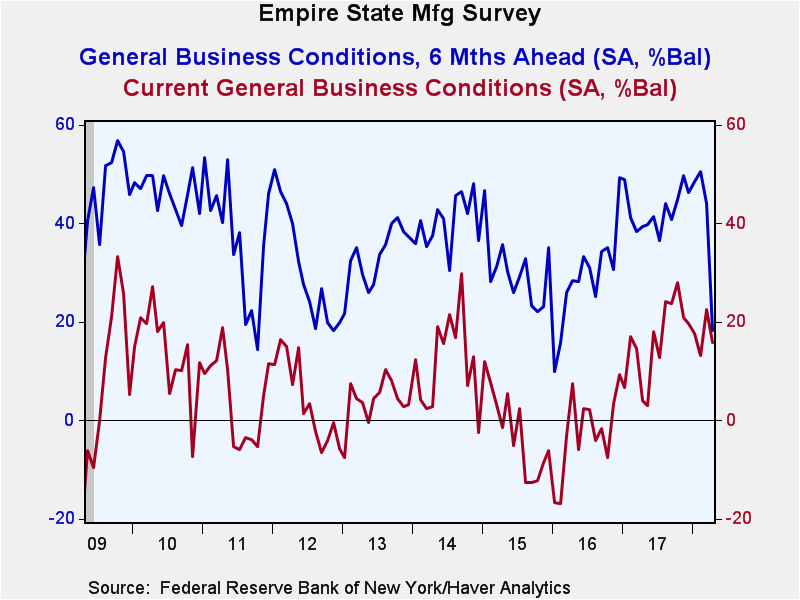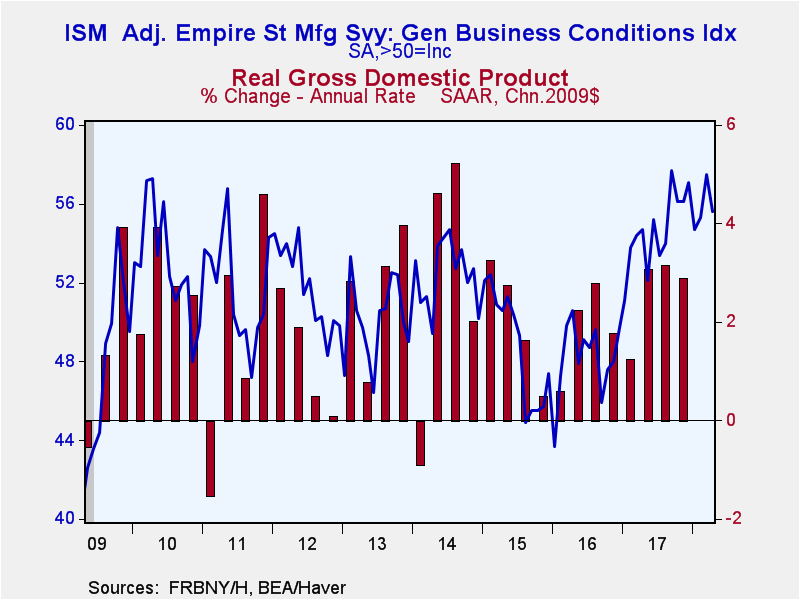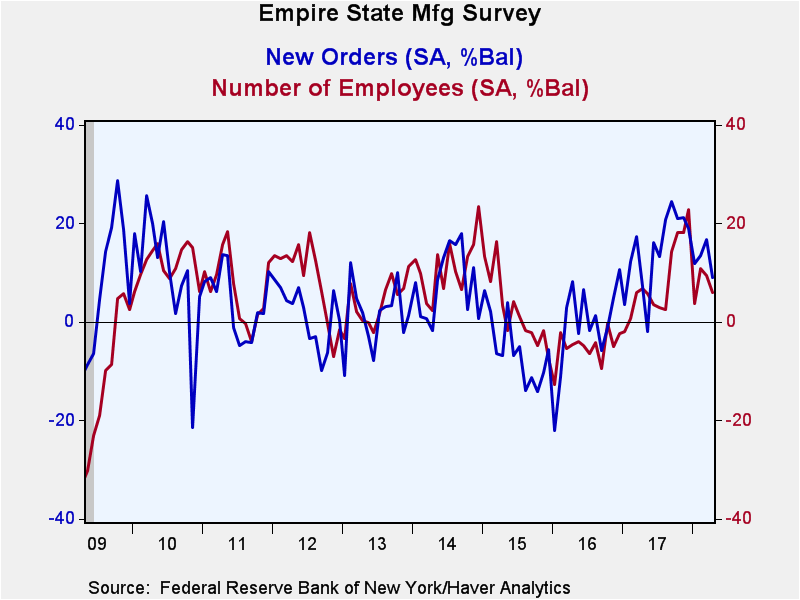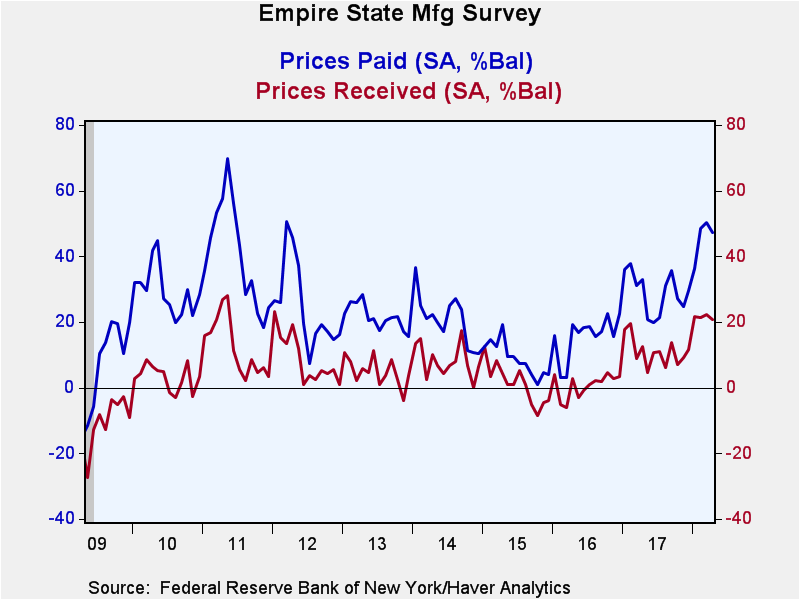 Global| Apr 16 2018
Global| Apr 16 2018Empire State Manufacturing Index Weakens
by:Tom Moeller
|in:Economy in Brief
Summary
The Empire State Manufacturing Index of General Business Conditions declined to 15.8 during April after jumping to 22.5 in March. Expectations had been for 18.6 in the Action Economics Forecast Survey. These data, reported by the [...]
The Empire State Manufacturing Index of General Business Conditions declined to 15.8 during April after jumping to 22.5 in March. Expectations had been for 18.6 in the Action Economics Forecast Survey. These data, reported by the Federal Reserve Bank of New York, reflect business conditions in New York, northern New Jersey and southern Connecticut.
Haver Analytics calculates a seasonally adjusted index that is comparable to the ISM series. The calculated figure declined to 55.6 from 57.5. During the last ten years, the index had a 69% correlation with the quarter-on-quarter change in real GDP.
Most of the series in the Empire State Survey deteriorated in April. The new orders index fell to 9.0 in April from 16.8, its lowest level since May 2017. The shipments index retraced most of its March increase with a decline to 17.5. Delivery times eased to 15.6 from 16.2, but still indicated nearly the slowest product delivery speeds of the recovery. The inventory index rose to 8.1, the highest level in three months.
The number of employees reading fell to 6.0, the lowest level in three months. During the last ten years, there has been a 77% correlation between the employment index and the month-on-month change in factory sector payrolls. While 16% of respondents reported a higher payroll level, 10% reported a lower hiring level. Working the other way, the employee workweek reading increased sharply to 16.9, the highest level since May 2009.
The prices paid index eased to 47.4, backing away from its highest level since March 2012. Forty-nine percent of respondents indicated increased prices, while just two percent reported a decline. Prices received also fell slightly to 20.7 from its roughly six-year peak.
Accompanying the decline in optimism about current conditions, the series measuring expectations of business conditions in six months plummeted to 18.3 in April from 44.1 in March. It was the lowest level in nearly two years. Most of the expectation series declined precipitously, except prices paid and technology spending.
The Empire State figures are diffusion indexes, which are calculated by subtracting the percent of respondents reporting declines from those reporting gains. The data are available in Haver's SURVEYS database. The ISM-adjusted headline index dates back to 2001. The Action Economics Forecasts can be found in Haver's AS1REPNA database.
| Empire State Manufacturing Survey | Apr | Mar | Feb | Apr'17 | 2017 | 2016 | 2015 |
|---|---|---|---|---|---|---|---|
| General Business Conditions (Diffusion Index, %, SA) | 15.8 | 22.5 | 13.1 | 4.1 | 16.1 | -2.6 | -2.3 |
| General Business Conditions Index (ISM Adjusted, >50=Increasing Activity, SA) | 55.6 | 57.5 | 55.3 | 54.7 | 54.6 | 48.2 | 48.8 |
| New Orders | 9.0 | 16.8 | 13.5 | 7.3 | 14.6 | -0.8 | -5.6 |
| Shipments | 17.5 | 27.0 | 12.5 | 12.8 | 15.9 | 1.9 | 4.0 |
| Unfilled Orders | 3.7 | 12.7 | 4.9 | 12.4 | 1.9 | -8.8 | -10.5 |
| Delivery Time | 15.6 | 16.2 | 11.1 | 16.1 | 6.1 | -4.8 | -5.3 |
| Inventories | 8.1 | 5.6 | 4.9 | 3.6 | 1.5 | -9.6 | -7.1 |
| Number of Employees | 6.0 | 9.4 | 10.9 | 6.9 | 8.3 | -5.1 | 2.3 |
| Average Employee Workweek | 16.9 | 5.9 | 4.6 | 6.8 | 4.9 | -5.2 | -4.8 |
| Prices Paid | 47.4 | 50.3 | 48.6 | 32.8 | 29.0 | 15.7 | 8.8 |
| Prices Received | 20.7 | 22.4 | 21.5 | 12.4 | 11.0 | 0.7 | 1.2 |
| Expectations 6 Months Ahead | 18.3 | 44.1 | 50.5 | 39.4 | 42.6 | 29.0 | 30.3 |
Tom Moeller
AuthorMore in Author Profile »Prior to joining Haver Analytics in 2000, Mr. Moeller worked as the Economist at Chancellor Capital Management from 1985 to 1999. There, he developed comprehensive economic forecasts and interpreted economic data for equity and fixed income portfolio managers. Also at Chancellor, Mr. Moeller worked as an equity analyst and was responsible for researching and rating companies in the economically sensitive automobile and housing industries for investment in Chancellor’s equity portfolio. Prior to joining Chancellor, Mr. Moeller was an Economist at Citibank from 1979 to 1984. He also analyzed pricing behavior in the metals industry for the Council on Wage and Price Stability in Washington, D.C. In 1999, Mr. Moeller received the award for most accurate forecast from the Forecasters' Club of New York. From 1990 to 1992 he was President of the New York Association for Business Economists. Mr. Moeller earned an M.B.A. in Finance from Fordham University, where he graduated in 1987. He holds a Bachelor of Arts in Economics from George Washington University.










